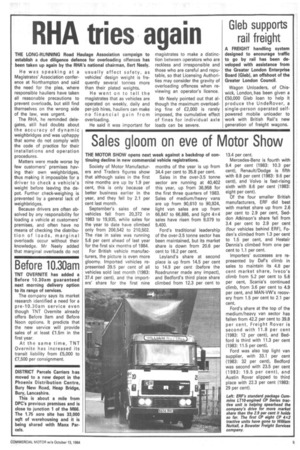Sales gloom on eve of Motor Show
Page 7

If you've noticed an error in this article please click here to report it so we can fix it.
THE MOTOR SHOW opens next week against a backdrop of continuing decline in new commercial vehicle registrations.
Society of Motor Manufacturers and Traders figures show that although sales in the first nine months are up by 1.9 per cent, this is only because of better business earlier in the year, and they fell by 2.1 per cent last month.
September's sales of new vehicles fell from 20,372 in 1983 to 19,935, while sales for the year to date have climbed only from 206,542 to 210,502. The rise in sales was running 5.6 per cent ahead of last year for the first six months of 1984.
For British vehicle manufacturers, the picture is even more gloomy. Imported vehicles represented 39.5 per cent of all vehicles sold last month (1983: 37.4 per cent), and the importers' share for the first nine months of the year is up from 34.4 per cent to 35.8 per cent.
Sales in the over-3.5 tonne sector are running at 40,402 this year, up from 36,958 for the first three quarters of 1983. Sales of medium/heavy vans are up from 90,610 to 90,924, light van sales are up from 66,847 to 66,886, and light 4x4 sales have risen from 9,079 to 9,400.
Ford's traditional leadership of the over-3.5 tonne sector has been maintained, but its market share is down from 20.6 per cent to 18.2 per cent.
Leyland's share at second place is up from 14.5 per cent to 14.9 per cent (before the Roadrunner made any impact), and Bedford's third place share climbed from 12.3 per cent to 13.4 per cent.
Mercedes-Benz is fourth with 9.4 per cent (1983: 10.3 per cent), Renault/Dodge is fifth with 8.8 per cent (1983: 9.6 per cent), and Volvo is fast-rising sixth with 8.6 per cent (1983: eight per cent).
Of the four smaller British manufacturers, ERF did best with market share up from 2.6 per cent to 2.9 per cent, Seddon Atkinson's share fell from 3.4 per cent to 2.9 per cent (four vehicles behind ERF), Foden's climbed from 1.3 per cent to 1.5 per cent, and Hestair Dennis's climbed from one per cent to 1.1 per cent.
Importers' successes are represented by Daf's climb in sales to maintain its 4.8 per cent market share, Iveco's climb from 5.2 per cent to 5.6 per cent, Scania's continued climb, from 3.6 per cent to 4.9 per cent, and MAN-VW`s recovery from 1.5 per cent to 2.1 per cent.
Ford's share at the top of the medium/heavy van sector has fallen from 42.2 per cent to 39.8 per cent, Freight Rover is second with 11.8 per cent (1983: 12 per cent), and Bedford is third with 11.3 per cent (1983: 11.5 per cent).
Ford was also top light van supplier, with 33.1 per cent (1983: 32 per cent), Bedford was second with 23.5 per cent (1983: 19.5 per cent), and Austin Rover slipped to third place with 22.3 per cent (1983: 29 per cent).
















































































































































